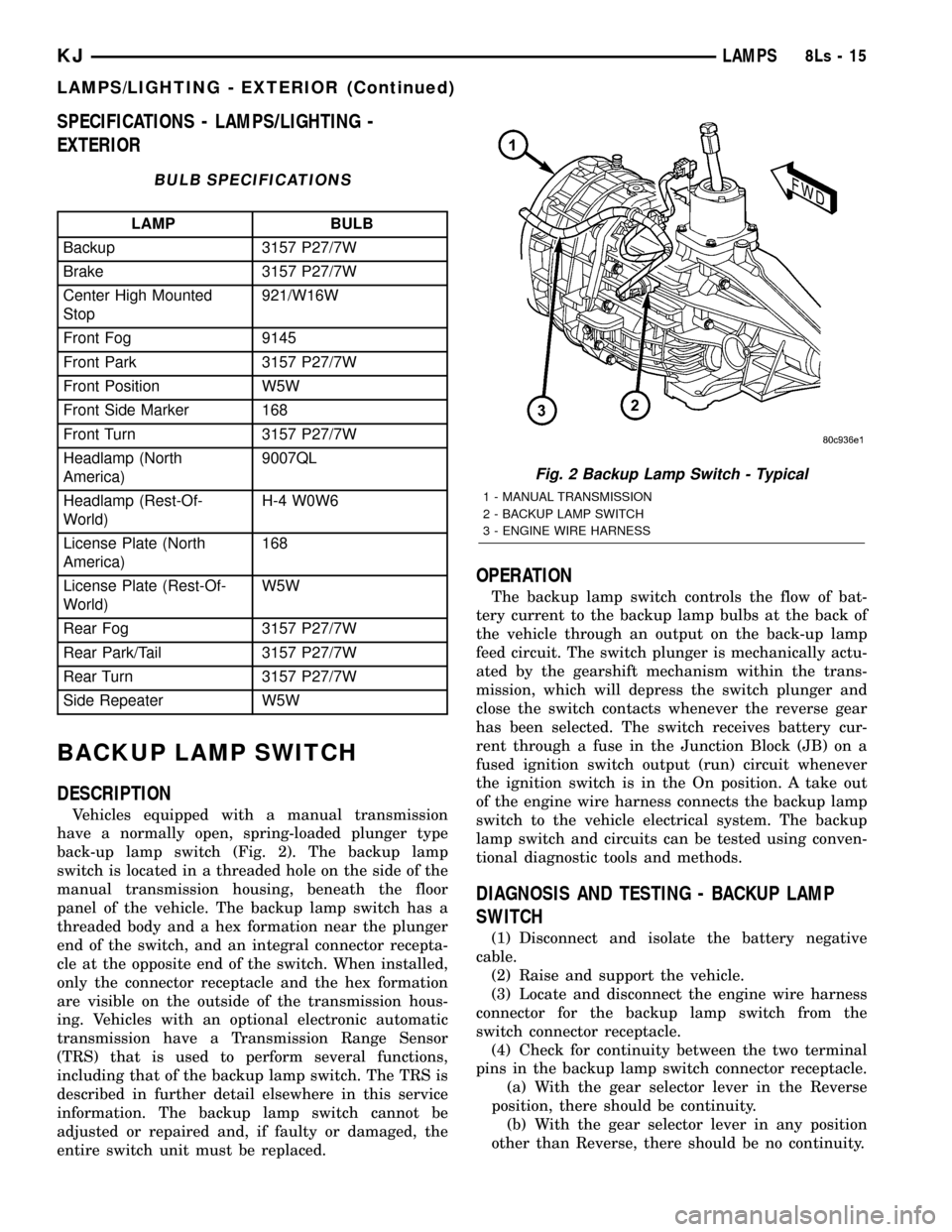Fuse JEEP LIBERTY 2002 KJ / 1.G Owners Manual
[x] Cancel search | Manufacturer: JEEP, Model Year: 2002, Model line: LIBERTY, Model: JEEP LIBERTY 2002 KJ / 1.GPages: 1803, PDF Size: 62.3 MB
Page 535 of 1803

FRONT FOG LAMPS
CONDITION POSSIBLE CAUSES CORRECTION
FRONT FOG LAMP DOES
NOT ILLUMINATE1. Faulty or missing fuse. 1. Test and replace front fog lamp fuse as
required.
2. Faulty or missing bulb. 2. Test and replace front fog lamp bulb as
required.
3. Faulty or missing relay. 3. Test and replace front fog lamp relay as
required.
4. Faulty switch. 4. Test and replace multi-function switch as
required.
5. Faulty ground circuit. 5. Test and repair front fog lamp ground
circuit as required.
6. Faulty feed circuit. 6. Test and repair open front fog lamp relay
output circuit as required.
7. Faulty BCM inputs or outputs. 7. Use a DRBIIITscan tool to test the BCM
inputs and outputs. Refer to the appropriate
diagnostic information.
FRONT FOG LAMP DOES
NOT EXTINGUISH1. Faulty relay. 1. Test and replace front fog lamp relay as
required.
2. Faulty switch. 2. Test and replace multi-function switch as
required.
3. Faulty feed circuit. 3. Test and repair shorted front fog lamp
relay output circuit as required.
4. Faulty BCM inputs or outputs. 4. Use a DRBIIITscan tool to test the BCM
inputs and outputs. Refer to the appropriate
diagnostic information.
HAZARD WARNING LAMPS
Before performing the following tests, confirm
whether the left and right turn signals operate satis-
factorily. If the turn signals are inoperative or oper-ate improperly, diagnose and repair that problem
before attempting to repair the Hazard Warning
Lamps.
CONDITION POSSIBLE CAUSES CORRECTION
HAZARD WARNING
LAMPS DO NOT FLASH1. Faulty or missing fuse. 1. Test and replace hazard warning fuse as
required.
2. Faulty ground circuit. 2. Test and repair hazard switch ground
circuit as required.
3. Faulty feed circuit. 3. Test and repair open hazard switch fused
B(+) circuit as required.
4. Faulty switch/flasher. 4. Replace hazard switch/combination
flasher with a known good unit and check
operation. Replace hazard switch/
combination flasher unit if required.
8Ls - 10 LAMPSKJ
LAMPS/LIGHTING - EXTERIOR (Continued)
Page 536 of 1803

HEADLAMPS
CONDITION POSSIBLE CAUSES CORRECTION
HEADLAMP DOES NOT
ILLUMINATE1. Faulty or missing fuse. 1. Test and replace headlamp fuse as
required.
2. Faulty or missing bulb. 2. Test and replace headlamp bulb as
required.
3. Faulty or missing relay. 3. Test and replace low beam or high beam
relay as required. (Note: Vehicles with a
DRL relay do not use a high beam relay.
The DRL relay cannot be tested. Replace
DRL relay with a known good unit and
check operation. Replace DRL relay as
required.)
4. Faulty switch. 4. Test and replace multi-function switch as
required.
5. Faulty ground circuit. 5. Test and repair open headlamp ground
circuit as required.
6. Faulty feed circuit. 6. Test and repair open headlamp low
beam, high beam, or DRL relay output
circuit as required.
7. Faulty BCM inputs or outputs. 7. Use a DRBIIITscan tool to test the BCM
inputs and outputs. Refer to the appropriate
diagnostic information.
HEADLAMP DOES NOT
EXTINGUISH1. Faulty relay. 1. Test and replace low beam or high beam
relay as required. (Note: Vehicles with a
DRL relay do not use a high beam relay.
The DRL relay cannot be tested. Replace
DRL relay with a known good unit and
check operation. Replace DRL relay as
required.)
2. Faulty switch. 2. Test and replace multi-function switch as
required.
3. Faulty feed circuit. 3. Test and repair shorted headlamp low
beam, high beam, or DRL relay output
circuit as required.
4. Faulty BCM inputs or outputs. 4. Use a DRBIIITscan tool to test the BCM
inputs and outputs. Refer to the appropriate
diagnostic information.
KJLAMPS8Ls-11
LAMPS/LIGHTING - EXTERIOR (Continued)
Page 538 of 1803

PARK LAMPS
CONDITION POSSIBLE CAUSES CORRECTION
PARK LAMP DOES NOT
ILLUMINATE1. Faulty or missing fuse. 1. Test and replace park lamp fuse as
required.
2. Faulty or missing bulb. 2. Test and replace park lamp bulb as
required.
3. Faulty or missing relay. 3. Test and replace park lamp relay as
required.
4. Faulty switch. 4. Test and replace multi-function switch as
required.
5. Faulty ground circuit. 5. Test and repair open park lamp ground
circuit as required.
6. Faulty feed circuit. 6. Test and repair open park lamp relay
output circuit as required.
7. Faulty BCM inputs or outputs. 7. Use a DRBIIITscan tool to test the BCM
inputs and outputs. Refer to the appropriate
diagnostic information.
PARK LAMP DOES NOT
EXTINGUISH1. Faulty relay. 1. Test and replace park lamp relay as
required.
2. Faulty switch. 2. Test and replace multi-function switch as
required.
3. Faulty feed circuit. 3. Test and repair shorted park lamp relay
output circuit as required.
4. Faulty BCM inputs or outputs. 4. Use a DRBIIITscan tool to test the BCM
inputs and outputs. Refer to the appropriate
diagnostic information.
REAR FOG LAMPS
CONDITION POSSIBLE CAUSES CORRECTION
REAR FOG LAMP DOES
NOT ILLUMINATE1. Faulty or missing fuse. 1. Test and replace rear fog lamp fuse as
required.
2. Faulty or missing bulb. 2. Test and replace rear fog lamp bulb as
required.
3. Faulty or missing relay. 3. Test and replace rear fog lamp relay as
required.
4. Faulty switch. 4. Test and replace multi-function switch as
required.
5. Faulty ground circuit. 5. Test and repair open rear fog lamp
ground circuit as required.
6. Faulty feed circuit. 6. Test and repair open rear fog lamp relay
output circuit as required.
7. Faulty BCM inputs or outputs. 7. Use a DRBIIITscan tool to test the BCM
inputs and outputs. Refer to the appropriate
diagnostic information.
KJLAMPS8Ls-13
LAMPS/LIGHTING - EXTERIOR (Continued)
Page 540 of 1803

SPECIFICATIONS - LAMPS/LIGHTING -
EXTERIOR
BULB SPECIFICATIONS
LAMP BULB
Backup 3157 P27/7W
Brake 3157 P27/7W
Center High Mounted
Stop921/W16W
Front Fog 9145
Front Park 3157 P27/7W
Front Position W5W
Front Side Marker 168
Front Turn 3157 P27/7W
Headlamp (North
America)9007QL
Headlamp (Rest-Of-
World)H-4 W0W6
License Plate (North
America)168
License Plate (Rest-Of-
World)W5W
Rear Fog 3157 P27/7W
Rear Park/Tail 3157 P27/7W
Rear Turn 3157 P27/7W
Side Repeater W5W
BACKUP LAMP SWITCH
DESCRIPTION
Vehicles equipped with a manual transmission
have a normally open, spring-loaded plunger type
back-up lamp switch (Fig. 2). The backup lamp
switch is located in a threaded hole on the side of the
manual transmission housing, beneath the floor
panel of the vehicle. The backup lamp switch has a
threaded body and a hex formation near the plunger
end of the switch, and an integral connector recepta-
cle at the opposite end of the switch. When installed,
only the connector receptacle and the hex formation
are visible on the outside of the transmission hous-
ing. Vehicles with an optional electronic automatic
transmission have a Transmission Range Sensor
(TRS) that is used to perform several functions,
including that of the backup lamp switch. The TRS is
described in further detail elsewhere in this service
information. The backup lamp switch cannot be
adjusted or repaired and, if faulty or damaged, the
entire switch unit must be replaced.
OPERATION
The backup lamp switch controls the flow of bat-
tery current to the backup lamp bulbs at the back of
the vehicle through an output on the back-up lamp
feed circuit. The switch plunger is mechanically actu-
ated by the gearshift mechanism within the trans-
mission, which will depress the switch plunger and
close the switch contacts whenever the reverse gear
has been selected. The switch receives battery cur-
rent through a fuse in the Junction Block (JB) on a
fused ignition switch output (run) circuit whenever
the ignition switch is in the On position. A take out
of the engine wire harness connects the backup lamp
switch to the vehicle electrical system. The backup
lamp switch and circuits can be tested using conven-
tional diagnostic tools and methods.
DIAGNOSIS AND TESTING - BACKUP LAMP
SWITCH
(1) Disconnect and isolate the battery negative
cable.
(2) Raise and support the vehicle.
(3) Locate and disconnect the engine wire harness
connector for the backup lamp switch from the
switch connector receptacle.
(4) Check for continuity between the two terminal
pins in the backup lamp switch connector receptacle.
(a) With the gear selector lever in the Reverse
position, there should be continuity.
(b) With the gear selector lever in any position
other than Reverse, there should be no continuity.
Fig. 2 Backup Lamp Switch - Typical
1 - MANUAL TRANSMISSION
2 - BACKUP LAMP SWITCH
3 - ENGINE WIRE HARNESS
KJLAMPS8Ls-15
LAMPS/LIGHTING - EXTERIOR (Continued)
Page 541 of 1803

BRAKE LAMP SWITCH
DESCRIPTION
The brake lamp switch is a three circuit, spring-
loaded plunger actuated switch that is secured to the
steering column support bracket under the driver
side of the instrument panel (Fig. 3). The brake lamp
switch is contained within a rectangular molded plas-
tic housing with an integral connector receptacle fea-
turing six terminal pins and a red plastic Connector
Position Assurance (CPA) lock. The switch is con-
nected to the vehicle electrical system through a ded-
icated take out and connector of the instrument
panel wire harness. The switch plunger extends
through a mounting collar on one end of the switch
housing. The plunger has a one time telescoping self-
adjustment feature that is achieved after the switch
is installed by moving an adjustment release lever on
the opposite end of the switch housing clockwise,
until it locks in a position that is parallel to the con-
nector receptacle. The brake lamp switch self-adjust-
ment is a one time feature. Once the feature has
been used, the switch cannot be readjusted. A ªDO
NOT RE-INSTALLº warning is molded into the
switch housing below the connector receptacle.
An installed brake lamp switch cannot be read-
justed or repaired. If the switch is damaged, faulty,
or removed from its mounting position for any rea-
son, it must be replaced with a new unit.
OPERATION
The brake lamp switch controls three different cir-
cuits, one normally open and two normally closed.
These circuits are described as follows:
²Brake Lamp Switch Circuit- A normally
open brake lamp switch circuit receives battery cur-
rent on a fused B(+) circuit from a fuse in the Junc-
tion Block (JB), and supplies battery current to the
brake lamps and the Controller Antilock Brake
(CAB) on a brake lamp switch output circuit when
the brake pedal is depressed (brake lamp switch
plunger released).
²Brake Lamp Switch Signal Circuit- A nor-
mally closed brake lamp switch signal circuit receives
a path to ground through a splice block located in the
instrument panel wire harness with an eyelet termi-
nal connector that is secured by a nut to a ground
stud on the driver side instrument panel end bracket
near the Junction Block (JB). This circuit supplies a
ground input to the Powertrain Control Module
(PCM) on a brake lamp switch sense circuit when the
brake pedal is released (brake lamp switch plunger is
depressed).
²Speed Control Circuit- A normally closed
speed control circuit receives battery current from
the Powertrain Control Module on a speed control
supply circuit, and supplies battery current to the
speed control servo solenoids (dump, vacuum, and
vent) on a speed control brake switch output circuit
when the speed control system is turned on and the
brake pedal is released (brake lamp switch plunger is
depressed).
Concealed within the brake lamp switch housing
the components of the self-adjusting brake switch
plunger consist of a two-piece telescoping plunger, a
split plunger locking collar, and a release wedge. The
release lever has an integral shaft with a wedge that
spreads the plunger locking collar to an open or
released position. After the switch is installed and
the brake pedal is released, the plunger telescopes to
the correct adjustment position. When the release
lever is moved to the release position, the wedge is
disengaged from the locking collar causing the collar
to apply a clamping pressure to the two plunger
halves fixing the plunger length.
The brake lamp switch can be diagnosed using con-
ventional diagnostic tools and methods.
Fig. 3 Brake Lamp Switch
1 - CONNECTOR RECEPTACLE
2 - BRAKE LAMP SWITCH
3 - PLUNGER
4 - COLLAR
5 - LEVER
8Ls - 16 LAMPSKJ
Page 544 of 1803

INSTALLATION
CAUTION: Always use the correct bulb size and
type for replacement. An incorrect bulb size or type
may overheat and cause damage to the lamp, the
socket and/or the lamp wiring.
(1) Align the base of the bulb with the receptacle
in the Center High Mounted Stop Lamp (CHMSL)
unit socket.
(2) Push the bulb straight into the CHMSL unit
socket until it is firmly seated.
(3) Align the socket and bulb with the socket open-
ing on the back of CHMSL unit housing.
(4) Push the socket and bulb straight into the
CHMSL unit housing until it is firmly seated (Fig. 6).
(5) Rotate the socket on the back of the CHMSL
unit housing clockwise about 30 degrees.
(6) Reinstall the CHMSL unit onto the roof panel.
(Refer to 8 - ELECTRICAL/LAMPS/LIGHTING -
EXTERIOR/CENTER HIGH MOUNTED STOP
LAMP UNIT - INSTALLATION).
(7) Reconnect the battery negative cable.
CENTER HIGH MOUNTED
STOP LAMP UNIT
REMOVAL
(1) Disconnect and isolate the battery negative
cable.
(2) Remove the two screws that secure the Center
High Mounted Stop Lamp (CHMSL) unit to the rear
of the roof panel (Fig. 7).
(3) Pull the CHMSL unit away from the roof panel
far enough to access and disconnect the wire harness
connector for the CHMSL unit from the lamp socket
pigtail wire.
(4) Remove the CHMSL unit from the roof panel.
INSTALLATION
(1) Position the Center High Mounted Stop Lamp
(CHMSL) unit to the roof panel.
(2) Reconnect the wire harness connector for the
CHMSL unit to the lamp socket pigtail wire (Fig. 7).
(3) Position the CHMSL unit into the roof panel
opening.
(4) Install and tighten the two screws that secure
the CHMSL unit to the rear of the roof panel.
Tighten the screws to 2 N´m (21 in. lbs.).
(5) Reconnect the battery negative cable.
COMBINATION FLASHER
DESCRIPTION
The combination flasher for this model is integral
to the hazard switch located in the center of the
instrument panel, just above the radio. The combina-
tion flasher is a smart relay that functions as both
the turn signal system and the hazard warning sys-
tem flasher. The combination flasher contains active
electronic Integrated Circuitry (IC) elements. This
flasher is designed to handle the current flow
requirements of the factory-installed lighting. If sup-
plemental lighting is added to the turn signal lamp
circuits, such as when towing a trailer with lights,
the combination flasher will automatically try to
compensate to keep the flash rate the same.
The combination flasher cannot be repaired or
adjusted and, if faulty or damaged, the hazard switch
unit must be replaced.
OPERATION
The combination flasher has the following inputs and
outputs: fused B(+), fused ignition switch output, right
turn signal sense, left turn signal sense, and one out-
put each for the right and left turn signal circuits. The
combination flasher also receives an internal input
through the closed contacts of the hazard switch and,
on vehicles equipped with the optional Vehicle Theft
Security System (VTSS), the flasher receives an input
from the Body Control Module (BCM) in order to flash
the turn signal lamps as an optical alert feature of that
Fig. 7 Center High Mounted Stop Lamp Remove/
Install
1 - ROOF PANEL
2 - BODY WIRE HARNESS CONNECTOR
3 - BULB SOCKET
4 - CHMSL
5 - SCREW (2)
6 - PLASTIC NUT (2)
KJLAMPS8Ls-19
CENTER HIGH MOUNTED STOP LAMP BULB (Continued)
Page 545 of 1803

system. Constant battery voltage is supplied to the
flasher so that it can perform the hazard warning func-
tion, and ignition switched battery voltage is supplied
for the turn signal function. The Integrated Circuit (IC)
within the combination flasher contains the logic that
controls the flasher operation and the flash rate. The
IC receives separate sense ground inputs from the
multi-function switch for the right and left turn sig-
nals, and from the hazard switch contacts or the BCM
for the hazard warning signals. A special design feature
of the combination flasher allows it to9sense9that a
turn signal circuit or bulb is not operating, and provide
the driver an indication of the condition by flashing the
remaining bulbs in the affected circuit at a higher rate
(120 flashes-per-minute or higher). Conventional flash-
ers either continue flashing at their typical rate (heavy-
duty type), or discontinue flashing the affected circuit
entirely (standard-duty type).
Because of the active electronic elements within
the combination flasher, it cannot be tested with con-
ventional automotive electrical test equipment. If the
combination flasher is believed to be faulty, test the
turn signal and hazard warning system. Then
replace the hazard switch with a known good unit to
confirm system operation.
DAYTIME RUNNING LAMP
RELAY
DESCRIPTION
The Daytime Running Lamp (DRL) relay (Fig. 8) is
a solid state relay that is used only on vehicles man-
ufactured for sale in Canada. The DRL relay featuresa die cast aluminum housing with integral cooling
fins that act as a heat sink for the solid state DRL
circuitry. Four male spade terminals extend from the
base of the relay through a potting material that
encloses and protects the DRL circuitry. Although the
DRL relay has four terminals that are laid out in a
footprint that is similar to that of a conventional
International Standards Organization (ISO) relay, a
standard ISO relay should never be installed in place
of the DRL relay. The DRL relay is installed in the
Junction Block (JB) on the driver side outboard end
of the instrument panel. Vehicles equipped with this
relay do not have a headlamp high beam relay
installed in the JB.
The DRL relay cannot be adjusted or repaired and,
if faulty or damaged, the unit must be replaced.
OPERATION
The Daytime Running Lamp (DRL) relay is a solid
state relay that controls the flow of battery current
to the high beam filaments of both headlamp bulbs
based upon a duty cycled control input received from
the Body Control Module (BCM) of vehicles equipped
with the DRL feature. By cycling the DRL relay out-
put, the BCM controls the illumination intensity of
the high beam filaments. The DRL relay terminals
are connected to the vehicle electrical system through
a connector receptacle in the Junction Block (JB).
The inputs and outputs of the DRL relay include:
²Battery Current Input- The DRL relay
receives battery current on a fused B(+) circuit from
a fuse in the Power Distribution Center (PDC).
²Ground Input- The DRL relay receives a path
to ground through a splice block located in the
instrument panel wire harness with an eyelet termi-
nal connector that is secured by a nut to a ground
stud on the driver side instrument panel end bracket
near the Junction Block (JB).
²Control Input- The DRL relay control input is
received from the BCM and/or the momentary optical
horn (flash-to-pass) output of the multi-function
switch through a high beam relay control circuit.
²Control Output- The DRL relay supplies bat-
tery current output to the headlamp high beam fila-
ments through the high beam relay output circuit.
Because of active electronic elements within the
DRL relay, it cannot be tested with conventional
automotive electrical test equipment. If the DRL
relay is believed to be faulty, replace the relay with a
known good unit to confirm system operation.
Fig. 8 Daytime Running Lamp Relay
1 - DRL RELAY
2 - HEAT SINK
3 - POTTING MATERIAL
4 - TERMINAL (4)
8Ls - 20 LAMPSKJ
COMBINATION FLASHER (Continued)
Page 548 of 1803

point. When the relay coil is de-energized, spring
pressure returns the movable contact point back
against the fixed normally closed contact point. A
resistor is connected in parallel with the relay coil in
the relay, and helps to dissipate voltage spikes and
electromagnetic interference that can be generated as
the electromagnetic field of the relay coil collapses.
The front fog lamp relay terminals are connected
to the vehicle electrical system through a connector
receptacle in the Junction Block (JB). The inputs and
outputs of the front fog lamp relay include:
²Common Feed Terminal- The common feed
terminal (30) receives battery current at all times
from a fuse in the JB through a fused B(+) circuit.
²Coil Ground Terminal- The coil ground termi-
nal (85) is connected to a control output of the pre-
mium Body Control Module (BCM) through a front
fog lamp relay control circuit. The BCM controls
front fog lamp operation by controlling a ground path
through this circuit.
²Coil Battery Terminal- The coil battery ter-
minal (86) receives battery current at all times from
a fuse in the JB through a fused B(+) circuit.
²Normally Open Terminal- The normally open
terminal (87) is connected to the front fog lamps
through a front fog lamp relay output circuit and
provides battery current to the front fog lamps when-
ever the relay is energized.
²Normally Closed Terminal- The normally
closed terminal (87A) is not connected in this appli-
cation.
The front fog lamp relay can be diagnosed using
conventional diagnostic tools and methods.
DIAGNOSIS AND TESTING - FRONT FOG LAMP
RELAY
The front fog lamp relay (Fig. 12) is located in the
Junction Block (JB) under the driver side outboard
end of the instrument panel. Refer to the appropriate
wiring information. The wiring information includes
wiring diagrams, proper wire and connector repair
procedures, details of wire harness routing and
retention, connector pin-out information and location
views for the various wire harness connectors, splices
and grounds.
WARNING: ON VEHICLES EQUIPPED WITH AIR-
BAGS, DISABLE THE SUPPLEMENTAL RESTRAINT
SYSTEM BEFORE ATTEMPTING ANY STEERING
WHEEL, STEERING COLUMN, DRIVER AIRBAG,
PASSENGER AIRBAG, SEAT BELT TENSIONER,
FRONT IMPACT SENSORS, SIDE CURTAIN AIRBAG,
OR INSTRUMENT PANEL COMPONENT DIAGNOSIS
OR SERVICE. DISCONNECT AND ISOLATE THE
BATTERY NEGATIVE (GROUND) CABLE, THEN
WAIT TWO MINUTES FOR THE SYSTEM CAPACI-TOR TO DISCHARGE BEFORE PERFORMING FUR-
THER DIAGNOSIS OR SERVICE. THIS IS THE ONLY
SURE WAY TO DISABLE THE SUPPLEMENTAL
RESTRAINT SYSTEM. FAILURE TO TAKE THE
PROPER PRECAUTIONS COULD RESULT IN ACCI-
DENTAL AIRBAG DEPLOYMENT AND POSSIBLE
PERSONAL INJURY.
(1) Remove the front fog lamp relay from the JB.
(Refer to 8 - ELECTRICAL/LAMPS/LIGHTING -
EXTERIOR/FRONT FOG LAMP RELAY - REMOV-
AL).
(2) A relay in the de-energized position should
have continuity between terminals 87A and 30, and
no continuity between terminals 87 and 30. If OK, go
to Step 3. If not OK, replace the faulty relay.
(3) Resistance between terminals 85 and 86 (elec-
tromagnet) should be 75 8 ohms. If OK, go to Step
4. If not OK, replace the faulty relay.
(4) Connect a battery to terminals 85 and 86.
There should now be continuity between terminals
30 and 87, and no continuity between terminals 87A
and 30. If OK, reinstall the relay and use a DRBIIIt
scan tool to perform further testing. Refer to the
appropriate diagnostic information.
Fig. 12 ISO Micro Relay
30 - COMMON FEED
85 - COIL GROUND
86 - COIL BATTERY
87 - NORMALLY OPEN
87A - NORMALLY CLOSED
KJLAMPS8Ls-23
FRONT FOG LAMP RELAY (Continued)
Page 554 of 1803

switch module housing is the hazard switch circuitry
and an electronic circuit board with the integral com-
bination flasher circuitry. The electronic combination
flasher circuitry performs both the hazard flasher
and turn signal flasher functions.
The hazard switch module cannot be adjusted or
repaired and, if faulty or damaged, the unit must be
replaced.
OPERATION
The hazard switch button is slightly recessed in
the instrument panel when the switch is in the Off
position, and latches at a position that is flush with
the outer surface of the instrument panel when in
the On position. The hazard switch module produces
an audible clicking sound that emulates the sound of
a conventional flasher whenever the turn signals or
the hazard warning system are activated. The hazard
switch module receives battery current on a fused
B(+) circuit from a fuse in the Junction Block (JB) at
all times for operation of the hazard warning, and on
a fused ignition switch output (run) circuit from
another fuse in the JB whenever the ignition switch
is in the On position for operation of the turn signals.
The module receives a path to ground through a
splice block located in the instrument panel wire har-
ness with an eyelet terminal connector that is
secured by a nut to a ground stud on the driver side
instrument panel end bracket near the JB. Inputs to
and outputs from the hazard switch module include:
²Panel Lamps Dimmer Input- A non-service-
able incandescent bulb soldered onto the hazard
switch module circuit board provides illumination of
the switch button when the exterior lighting is
turned On through an input received on the fusedpanel lamps dimmer switch signal circuit. However,
this bulb flashes on and off at full intensity whenever
the hazard switch button is in the On position,
regardless of the status of the exterior lighting.
²Hazard Switch Input- The combination
flasher circuitry of the hazard switch module receives
an internal ground input from the hazard switch to
request hazard flasher operation.
²Multi-Function Switch Input- The combina-
tion flasher circuitry of the hazard switch module
receives separate ground inputs from the turn signal
switch circuitry of the multi-function switch on right
and left turn switch sense circuits to request right or
left turn signal flasher operation.
²Body Control Module Input- The Body Con-
trol Module (BCM) can request hazard flasher opera-
tion by providing a ground path to the combination
flasher circuitry of the hazard switch module through
a hazard lamp control circuit.
²Turn Signal Output- The combination flasher
circuitry within the hazard switch module responds
to the flasher request inputs by energizing and
de-energizing two miniature relays on the module
circuit board. These relays control the switch output
through the right and left turn signal circuits. One
relay controls the right lamps, while the other con-
trols the left.
Because of active electronic elements within the
hazard switch module, it cannot be tested with con-
ventional automotive electrical test equipment. If the
hazard switch module is believed to be faulty, replace
the switch with a known good unit to confirm system
operation.
REMOVAL
WARNING: ON VEHICLES EQUIPPED WITH AIR-
BAGS, DISABLE THE SUPPLEMENTAL RESTRAINT
SYSTEM BEFORE ATTEMPTING ANY STEERING
WHEEL, STEERING COLUMN, DRIVER AIRBAG,
PASSENGER AIRBAG, SEAT BELT TENSIONER,
FRONT IMPACT SENSORS, SIDE CURTAIN AIRBAG,
OR INSTRUMENT PANEL COMPONENT DIAGNOSIS
OR SERVICE. DISCONNECT AND ISOLATE THE
BATTERY NEGATIVE (GROUND) CABLE, THEN
WAIT TWO MINUTES FOR THE SYSTEM CAPACI-
TOR TO DISCHARGE BEFORE PERFORMING FUR-
THER DIAGNOSIS OR SERVICE. THIS IS THE ONLY
SURE WAY TO DISABLE THE SUPPLEMENTAL
RESTRAINT SYSTEM. FAILURE TO TAKE THE
PROPER PRECAUTIONS COULD RESULT IN ACCI-
DENTAL AIRBAG DEPLOYMENT AND POSSIBLE
PERSONAL INJURY.
(1) Disconnect and isolate the battery negative
cable.
Fig. 21 Hazard Switch
1 - HAZARD SWITCH BUTTON
2 - SCREW (1)
3 - MOUNTING BRACKET TABS
KJLAMPS8Ls-29
HAZARD SWITCH (Continued)
Page 558 of 1803

(5) Position the outer circumference of the boot
seal over the flange on the back of the headlamp unit
housing and pull it downward until the seal is fully
engaged over the flange.
(6) Reinstall the headlamp unit onto the grille
opening reinforcement. (Refer to 8 - ELECTRICAL/
LAMPS/LIGHTING - EXTERIOR/HEADLAMP UNIT
- INSTALLATION).
(7) Reconnect the battery negative cable.
(8) Confirm proper headlamp unit alignment.
(Refer to 8 - ELECTRICAL/LAMPS/LIGHTING -
EXTERIOR/HEADLAMP UNIT - ADJUSTMENTS).
HEADLAMP HIGH BEAM
RELAY
DESCRIPTION
The headlamp high beam relay is located in the
Junction Block (JB) on the driver side outboard end
of the instrument panel in the passenger compart-
ment of the vehicle. The headlamp high beam relay
is omitted from vehicles manufactured for sale in
Canada, which have a Daytime Running Lamp (DRL)
solid state relay installed in the JB that also per-
forms the function of the headlamp high beam relay.
The headlamp high beam relay is a conventional
International Standards Organization (ISO) micro
relay (Fig. 28). Relays conforming to the ISO specifi-
cations have common physical dimensions, current
capacities, terminal patterns, and terminal functions.
The relay is contained within a small, rectangular,molded plastic housing and is connected to all of the
required inputs and outputs by five integral male
spade-type terminals that extend from the bottom of
the relay base.
The headlamp high beam relay cannot be adjusted
or repaired and, if faulty or damaged, the unit must
be replaced.
OPERATION
The headlamp high beam relay is an electrome-
chanical switch that uses a low current input from
the Body Control Module (BCM) to control a high
current output to the headlamp high beam filaments.
The movable common feed contact point is held
against the fixed normally closed contact point by
spring pressure. When the relay coil is energized, an
electromagnetic field is produced by the coil wind-
ings. This electromagnetic field draws the movable
relay contact point away from the fixed normally
closed contact point, and holds it against the fixed
normally open contact point. When the relay coil is
de-energized, spring pressure returns the movable
contact point back against the fixed normally closed
contact point. A resistor is connected in parallel with
the relay coil in the relay, and helps to dissipate volt-
age spikes and electromagnetic interference that can
be generated as the electromagnetic field of the relay
coil collapses.
The headlamp high beam relay terminals are con-
nected to the vehicle electrical system through a con-
nector receptacle in the Junction Block (JB). The
inputs and outputs of the headlamp high beam relay
include:
²Common Feed Terminal- The common feed
terminal (30) receives battery current at all times
from a fuse in the Power Distribution Center (PDC)
through a fused B(+) circuit.
²Coil Ground Terminal- The coil ground termi-
nal (85) is connected to a control output of the Body
Control Module (BCM) through a head lamp relay
control circuit. The BCM controls head lamp opera-
tion by controlling a ground path through this circuit
²Coil Battery Terminal- The coil battery ter-
minal (86) is connected to a control output of the
Body Control Module (BCM) and to the momentary
optical horn (flash-to-pass) output of the multi-func-
tion switch through a high beam relay control circuit.
The BCM and/or the multi-function switch controls
headlamp high beam operation by controlling a
ground path through this circuit.
²Normally Open Terminal- The normally open
terminal (87) is connected to the headlamp high
beam filaments through the high beam relay output
circuit and provides battery current to the headlamp
high beams whenever the relay is energized.
Fig. 28 ISO Micro Relay
30 - COMMON FEED
85 - COIL GROUND
86 - COIL BATTERY
87 - NORMALLY OPEN
87A - NORMALLY CLOSED
KJLAMPS8Ls-33
HEADLAMP BULB (Continued)